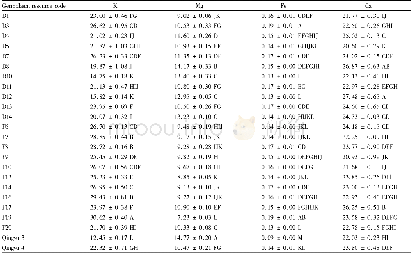《Table 1 The ossified elements of the hyobranchium in different fossil taxa》
 提示:宽带有限、当前游客访问压缩模式
提示:宽带有限、当前游客访问压缩模式
本系列图表出处文件名:随高清版一同展现
《河北围场下白垩统围场皇家螈(Regalerpeton weichangensis)(两栖类:有尾类)的再研究(英文)》
Based on:1) Skutschas and Martin,2011;2) Gao et al.,1998;3) Dong and Wang,1998;4) Wang,2000;5) Gao and Shubin,2001;6) Gao and Shubin,2003;7) Wang,2004;8) Wang and Evans,2006;9) Gao and Shubin,2012;10) Jia and Gao,2016a;11) Jia and Gao,2016b.
The hyobranchium lies in the floor of the mouth and supports the tongue.It varies in its configuration in different species(Table 1).In Chunerpeton,Beiyanerpeton,Qinglongtriton,and Regalerpeton,the hyobranchium consists of ossified hypobranchial I,hypobranchial II and basibranchial II,but the shape of basibranchial II differs among these taxa(Fig.7).It is triradiate in Regalerpeton.However,in Beiyanerpeton,basibranchial I and II are co-ossified to form a trident-shaped element with slender arms extending anteriorly and anterolaterally(Gao and Shubin,2012).In Chunerpeton,basibranchial II is trident-shaped(Gao and Shubin,2003),whereas in Qinglongtriton,it is more complex in shape,with paired anterolateral and posterolateral processes fused to a median rod(Jia and Gao,2016a).In modern salamanders,the paired ossified hypobranchial I and hypobranchial II and paralleled to each other,this occurs in the larval and neotenic salamanders like Siren intermedia,Pachyhynobius shangchengensis,Batrachuperus mustersi,Pseudobranchus striatus,Proteus anguinus,Amphiuma means,Desmognathus aeneus(Deban and Wake,2000;Rose,2003;Xiong et al.,2013).Accordingly,pairs of hypobranchial I and hypobranchial II present in fossil taxon are considered larval hyobranchium.
| 图表编号 | XD0020741400 严禁用于非法目的 |
|---|---|
| 绘制时间 | 2018.04.01 |
| 作者 | 戎钰芬 |
| 绘制单位 | 中国科学院古脊椎动物与古人类研究所中国科学院脊椎动物演化与人类起源重点实验室、中国科学院生物演化与环境卓越创新中心、中国科学院大学 |
| 更多格式 | 高清、无水印(增值服务) |
查看“Table 1 The ossified elements of the hyobranchium in different fossil taxa”的人还看了
-

- Table 2 Rare earth elements of different fabrics dolomite for member 4th, Dengying Fm.in the study area (1)
-

- Table 4.Element contents of the spots labeled in Fig.8 (c) of the completely leaching residue by EDS





